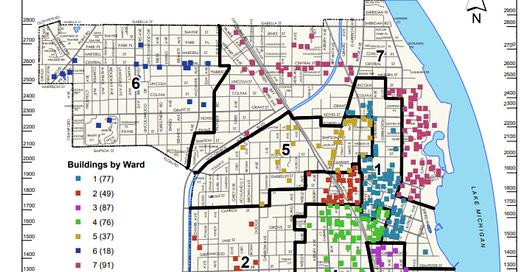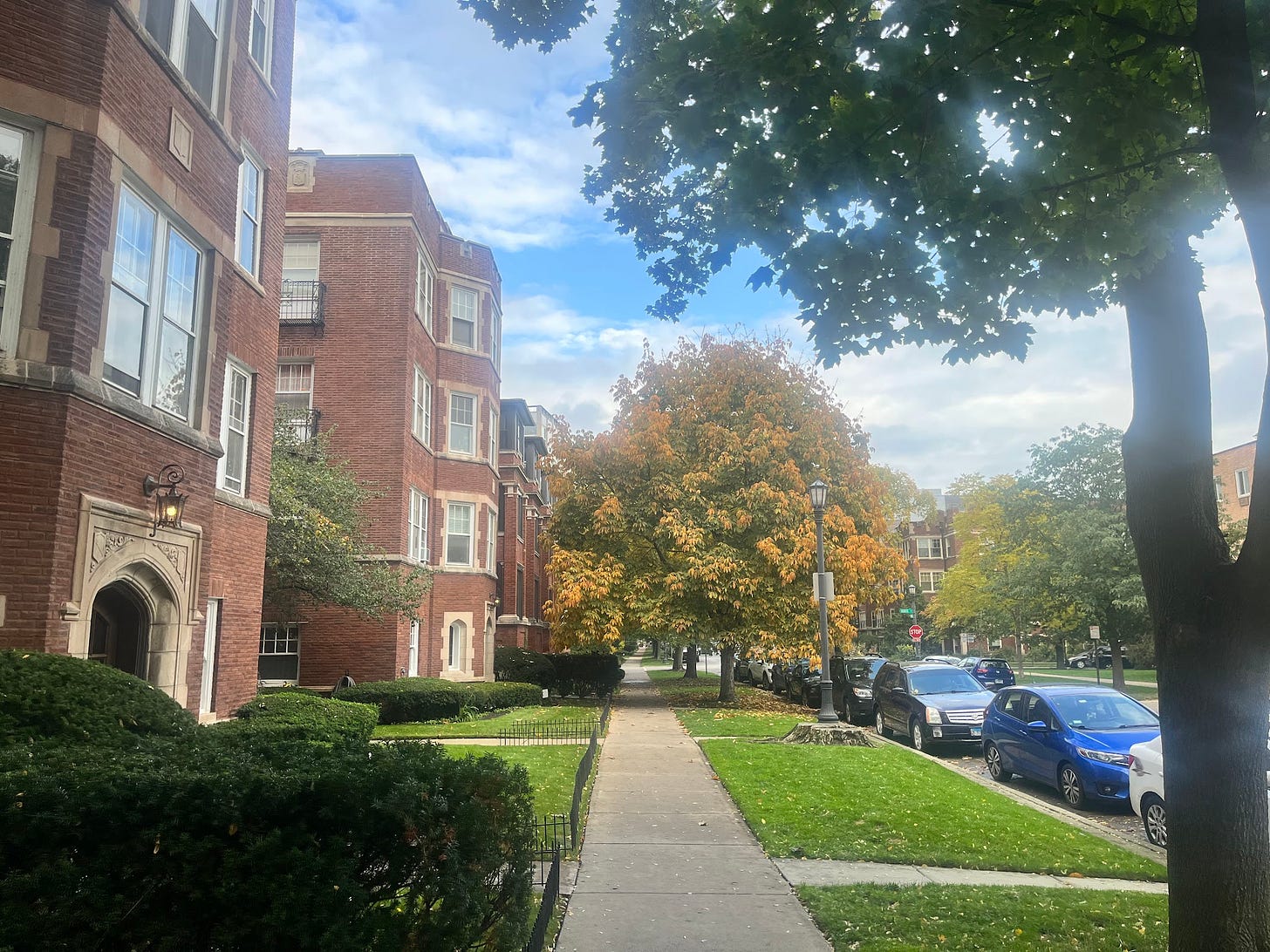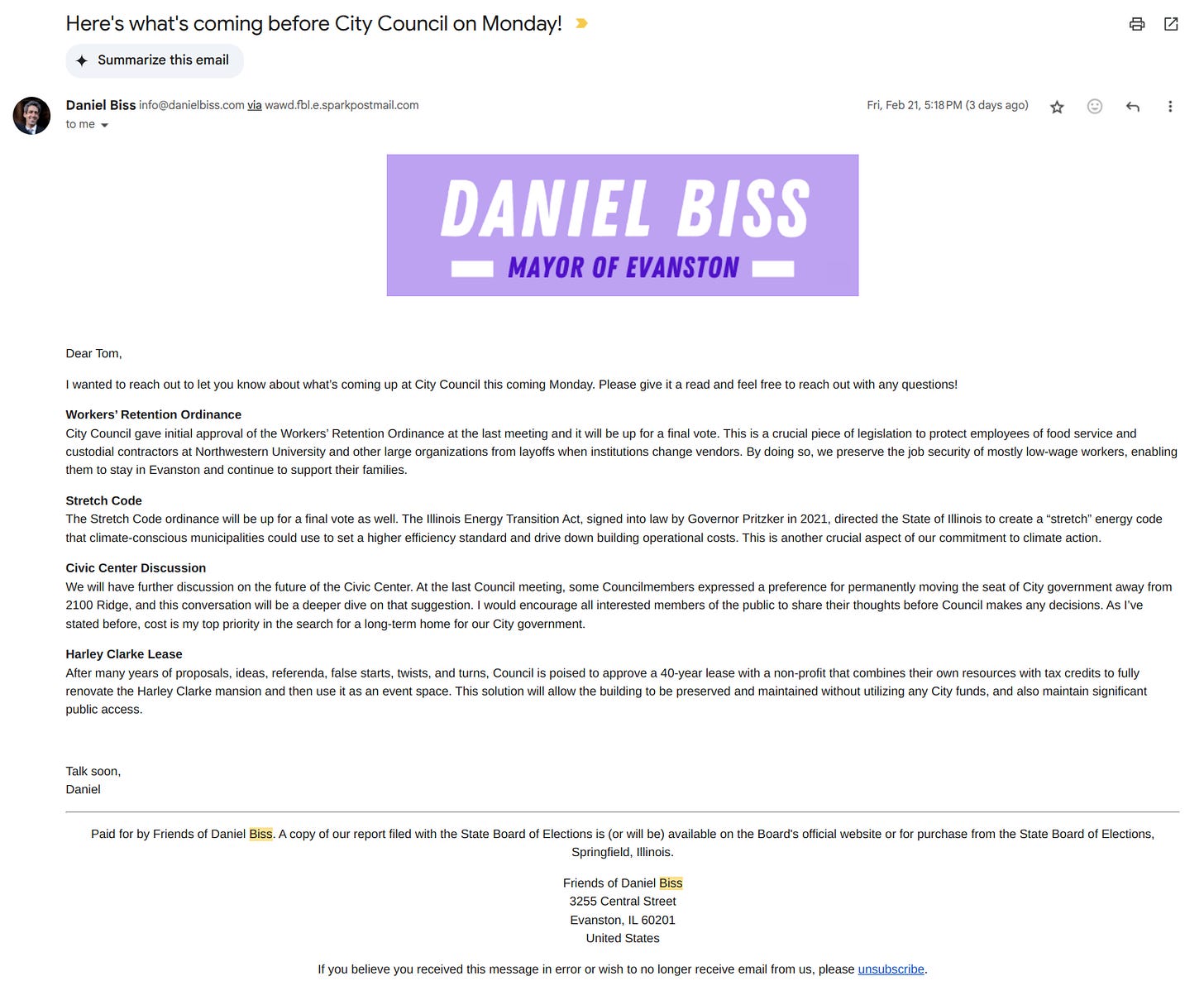City Council to vote on Costly (to you) Healthy Building Ordinance
CATALYZE DEMAND FOR HIGH-PERFORMING BUILDINGS.
Edit: I removed a section where I made some unverified claims about the origin of the electrons in our power lines (that they come mostly from a gas plant). Given that I don’t have proof for this, I’ve removed from the story
Tonight, the Evanston City Council will be voting on the Healthy Buildings Ordinance (HBO). You can read the ordinance at this link. It’s a pretty arcane document, but the justification for the ordinance is the desire to reduce natural gas consumption;
Natural gas used by buildings is currently the leading cause of greenhouse gas emissions in Evanston, responsible for approximately 41% of community-wide emissions. As of 2022, there has been a 36% reduction in greenhouse emissions from Evanston’s 2005 baseline. However, Evanston's natural gas usage has remained approximately constant in the last 20 years.
To address this, the Healthy Buildings Ordinance includes the following:
Establishing building performance standards: The HBO requires covered properties in Evanston to meet three final performance standards by 2050:
Energy efficiency measured by maximum normalized site Energy Use Intensity (EUI) - the actual EUI is to be determined by rulemaking process and is not in the ordinance.
Zero normalized onsite and district thermal greenhouse gas emissions
100% of electricity usage sourced through renewable electricity
Setting interim performance standards: Beginning June 30, 2031, covered properties must demonstrate progress toward the final performance standards by meeting interim standards every five years (2030, 2035, 2040, 2045, and 2050).
Creating an Alternative Compliance Pathway Plan (ACPP): This allows property owners who believe they cannot reasonably meet the standards to propose alternative plans for approval.
Establishing the Healthy Buildings Accountability Board: This community-led oversight body is authorized to make recommendations and decisions related to de-carbonization policies and programs, including the HBO.
Creating the Healthy Buildings Technical Committee: This committee is responsible for developing rules and procedures to implement the ordinance, recommending performance standards, and providing technical expertise.
The ordinance has a size threshold for determining which buildings are covered;
Buildings or groups of buildings with the same owner(s) having a gross floor area of 50,000 square feet or more
Municipally-owned buildings having a gross floor area of 10,000 square feet or more
It excludes condominium and co-ops less than 50,000 square feet. But this still includes a lot of buildings that would be need to be compliant by 2030 and then 2050. You can view the City’s slides on the ordinance. In total, according to the City there are around 506 buildings which will be subject to the ordinance.
The ordinance lacks in specificity and doesn’t include specific numbers on the metrics or even the fees. In theory, those will be determined by the two new committees that will be formed to oversee implementation of the HBO. In the 1/27/2025 meeting, this was defended by Councilmember Nieuwsma.
One of the elements of the amendments, gives City Council the responsibility to approve the rules that the Boards recommend … which is yet another forum for public engagement. I see no reason to delay this. Folks are saying, please wait we need to talk about it more. I’m saying, let’s get going so we can talk about it more.
Southeast Evanston Rent 📈
If you live in a large condo or apartment building, you will likely be impacted. This is a huge deal for the third ward, especially.
The 18 unit building I used to live at on Hinman and Kedzie is just over 50,000 square feet - so they would be required to electrify the boiler in the basement and in units - a massive expense. The ordinance isn’t clear to what extent things such as gas stoves are covered, but it seems like the intent is to remove all natural gas.
The third ward is great because there is still affordable housing - you can still get a two bedroom apartment for under $2,000. But they’re “vintage” apartments, which means radiator heat from a boiler, gas stove tops, and window air conditioners. Most of these buildings are greater than 50,000 total square feet and would be covered.
You can say, “screw landlords and Northwestern, we need net zero carbon energy now” but many of these buildings are condos with retired residents who live on fixed incomes. The rents here have already gone up from the Wirtz family selling their properties to private equity. The five or six figure special assessments required to upgrade the boilers will absolutely price fix income people out of the neighborhood. The units that aren’t condos are still affordable apartments, in the sense that regular people can still afford to live here (they’re not legally affordable housing, which is a whole other thing).
This demonstrates the push-and-pull aspect of modern city planning - the City wants to encourage both affordable housing while also increasing the costs of owning properties to achieve some other political goal.
Lastly there is an “equity” based carve out, which includes churches and whatever the Accountability Board wants to carve out.
Religious institutions
Non-profit organizations
Affordable housing (in the legal sense of being government subsidized housing, not actually affordable housing like in the 3rd ward)
Other covered properties so designated by the Healthy Buildings Accountability Board (???)
I’m not entirely sure how any of this is an equity thing, but I’m not writing the rules here.
Who’s Writing the Rules? ✍️
According to the memo attached to the ordinance, a handful of outside entities were deeply involved in the crafting of the ordinance;
A keystone non-profit organization in the development of similar BPS is the Institute for Market Transformation (IMT). IMT has helped several municipalities adopt benchmarking and or BPS policies. IMT has provided staff with model BPS ordinance language and extensive resources to approach this high-impact work equitably.
The Illinois Green Alliance, Slipstream, and the Midwest Energy Efficiency Alliance have provided expertise in utilities, policy design, building ownership, and building science. All four of these non-profits have been key to the policy design.
According to their 990, the Institute for Market Transformation (IMT) is a non-profit with a pretty hard-core mission that I want to put on a t-shirt;
CATALYZE DEMAND FOR HIGH-PERFORMING BUILDINGS.
One surefire way to “catalyze demand for high-performing buildings” is to convince cities to pass laws mandating public and private buildings upgrade electrical equipment. According to their 2023 annual report, the IMT is funded by a variety of different entities from philanthropic arms, to the Department of Energy, to a bunch of commercial HVAC vendors including as Rockwool, legrand, Johnson Controls, Yardi, Boland, and Ameresco.
The other non-profits involved include Slipstream (IRS 990), headquartered at 431 Catalyst Way (I can’t handle all this catalyzing!) or the Midwest Energy Efficient Alliance (IRS 990). Slipstream, an organization with almost $40 million in annual revenue describes its mission in even more hard-core terms.
ACCELERATING CLIMATE SOLUTIONS. FOR EVERYONE. SLIPSTREAM ADOPTED THIS NEW MISSION STATEMENT IN 2020 TO REFLECT OUR COMMITMENT TO INCREASING THE SPEED AND SCALE OF CLIMATE MITIGATION AND RESILIENCE. WE HAVE ALSO COMMITTED TO EQUITY AND INCLUSION, PRIORITIZING WORK THAT PUSHES BACK AGAINST THE HISTORIC INEQUITIES OF THE ENERGY EFFICIENCY INDUSTRY, CENTERS THE PERSPECTIVES OF BІРOC COMMUNITIES IN CLIMATE SOLUTIONS, AND DELIVERS EQUITABLE BENEFITS TO PEOPLE WHO HAVE BEEN LEFT BEHIND IN THE CLEAN ENERGY TRANSITION. SLIPSTREAM MEASURES OUR MISSION IMPACT IN GREENHOUSE GAS REDUCTIONS, ENERGY SAVINGS, INNOVATION, AND HEALTH.
It’s not obvious how Slipstream is funded, but they host websites for Comed’s efficiency programs, so there may be some relationship with Comed.
Anyway, the IMT has been at the last couple of City Council meetings to promote both the HBO and the the a $10.4 million dollar grant from the IRA Zero Energy Codes Grant Program.1 You can see the council members discuss both with Jessica Miller from the IMT at about 4:05:00 in the 1/27/2025 meeting;
Significant Costs💀
Based on the City’s memo, the cost to building owners is no joke;
A reasonable range for typical total costs to owners of buildings that currently have an EUI that exceeds the assumed 2030 threshold may fall between $9/sf and $15/SF.
For that 55,000 square foot 18 unit condo building on Hinman and Kedzie, the cost will range between $495,000 ($27,500 per unit) and $825,000 ($45,833 per unit). I wouldn’t want to be on the condo board that approves that special assessment! For private landlords, the costs may just push them to redevelop the property, further stressing affordable housing.
The City and the folks from the IMT have suggested there are grants and funds available for private entities to upgrade, but many of these require government agencies that are friendly to the cause, including the Department of Energy, currently run by a shale energy guy.
One final thing - since Mayor Biss started his campaign in earnest, he’s been emailing out weekly lists of things the Council will be working on. Strangely enough, he seems to have excluded the HBO from this week’s email, despite the fact it’s on the agenda. 🤔
For now, put aside whether they will actually get that money, given the impoundment of IRA and Department of Energy funds. See my post from last week for a specific example of a statutory program that is effectively dead.







I appreciated that bit about Biss’ new found ‘updates from the council’ that he decided to start weeks before the election. (If you want to share what’s going on, why haven’t you been doing this all along, Dan?)
I was a supporter of Biss initially but this thing, the Envision Evanston stuff, etc….: it all is about building trendy sounding stuff for his resume that he can use to parlay into an assistant Secretary gig in the next Democratic administration.
It makes me more and more likely I’ll vote for Jeff.
Thanks for reminding everyone that electrification is not the same as de-carbonization! (This also includes electric cars I’m afraid.) Do electric boilers even have the BTUs to heat large buildings in the IL cold? Heat pumps are still not up to the job, a big problem to moving away from natural gas for single family homes. I too lived in courtyard buildings in SE Evanston. It is impossible to think these are easy to retrofit. It’s all just another “let’s do ___ and all feel good we did something” rather than finding a legitimate solution. It seems to plague politics in this town.